Composition Design and Tensile Properties of Additive Manufactured Low Density Hf-Nb-Ta-Ti-Zr High Entropy Alloys Based on Atomic Simulations
Abstract
1. Introduction
2. Materials and Methods
2.1. MD Model and Method
2.2. Experimental Materials and Methods
3. Results and Discussion
3.1. Effects of Hf and Ta Contents
3.2. Preparation and Study of As-Deposited Samples
4. Conclusions
- Through MD simulation, it is found that the strength of HEA decreases with the decrease of Ta content, while increases with the decrease of Hf content. This result is consistent with the experimental results of the existing research. The reliability of the simulation results has been preliminarily confirmed.
- The atomic ratios of Hf and Ta elements were adjusted synchronously, and their effects on the performance of HEA were simulated. The results show that as the ratio of the two elements decreases, the yield strength and elastic modulus of HEA decrease. A small amount of as-cast HEA samples with the same composition were prepared and tested. The variation trend of properties obtained by the test is consistent with the MD simulation results which further confirms the reference value of the MD simulation results.
- A low-density HEA composition was designed based on MD simulation results and successfully used in LMD forming. The as-deposited samples have good density, and the deposition efficiency first increases and then decreases with the increase of laser power.
- Compared with as-cast HEA, as-deposited HEA has finer grains and higher mechanical properties. Compared with the as-cast equiatomic ratio HfNbTaTiZr HEA, the as-deposited Hf0.25NbTa0.25TiZr HEA has lower density and similar mechanical properties. Pre-planned engineering goal has been successfully achieved.
Author Contributions
Funding
Institutional Review Board Statement
Informed Consent Statement
Data Availability Statement
Acknowledgments
Conflicts of Interest
References
- Huang, P.K.; Yeh, J.W.; Shun, T.T.; Chen, S.K. Multi-Principal-Element Alloys with Improved Oxidation and Wear Resistance for Thermal Spray Coating. Adv. Eng. Mater. 2004, 6, 74–78. [Google Scholar] [CrossRef]
- Yeh, J.W.; Chen, S.K.; Lin, S.J.; Gan, J.Y.; Chin, T.S.; Shun, T.T.; Tsau, C.H.; Chang, S.Y. Nanostructured High-Entropy Alloys with Multiple Principal Elements: Novel Alloy Design Concepts and Outcomes. Adv. Eng. Mater. 2004, 6, 299–303. [Google Scholar] [CrossRef]
- Lu, Z.P.; Wang, H.; Chen, M.W.; Baker, I.; Yeh, J.W.; Liu, C.T.; Nieh, T.G. An Assessment On the Future Development of High-Entropy Alloys: Summary From a Recent Workshop. Intermetallics 2015, 66, 67–76. [Google Scholar] [CrossRef]
- Biswas, K.; Yeh, J.; Bhattacharjee, P.P.; DeHosson, J.T.M. High Entropy Alloys: Key Issues Under Passionate Debate. Scripta Mater. 2020, 188, 54–58. [Google Scholar] [CrossRef]
- Chen, W.; Fu, Z.; Fang, S.; Xiao, H.; Zhu, D. Alloying Behavior, Microstructure and Mechanical Properties in a FeNiCrCo0.3Al0.7 High Entropy Alloy. Mater. Des. 2013, 51, 854–860. [Google Scholar] [CrossRef]
- Reddy, S.R.; Sunkari, U.; Lozinko, A.; Guo, S.; Bhattacharjee, P.P. Development and Homogeneity of Microstructure and Texture in a Lamellar AlCoCrFeNi2.1 Eutectic High-Entropy Alloy Severely Strained in the Warm-Deformation Regime. J. Mater. Res. 2019, 34, 687–699. [Google Scholar] [CrossRef]
- Han, J.; Su, B.; Meng, J.; Zhang, A.; Wu, Y. Microstructure and Composition Evolution of a Fused Slurry Silicide Coating on MoNbTaTiW Refractory High-Entropy Alloy in High-Temperature Oxidation Environment. Materials 2020, 13, 3592. [Google Scholar] [CrossRef]
- Jayaraj, J.; Thinaharan, C.; Ningshen, S.; Mallika, C.; Mudali, U.K. Corrosion behavior and surface film characterization of TaNbHfZrTi high entropy alloy in aggressive nitric acid medium. Intermetallics 2017, 89, 123–132. [Google Scholar] [CrossRef]
- Sheikh, S.; Shafeie, S.; Hu, Q.; Ahlstr, M.J.; Persson, C.; Vesely, J.; Zyka, J.Í.; Klement, U.; Guo, S. Alloy design for intrinsically ductile refractory high-entropy alloys. J. Appl. Phys. 2016, 120, 164902. [Google Scholar] [CrossRef]
- Liu, C.; Gadelmeier, C.; Lu, S.; Yeh, J.; Yen, H.; Gorsse, S.; Glatzel, U.; Yeh, A. Tensile creep behavior of HfNbTaTiZr refractory high entropy alloy at elevated temperatures. Acta Mater. 2022, 237, 118188. [Google Scholar] [CrossRef]
- Fan, X.J.; Qu, R.T.; Zhang, Z.F. Remarkably high fracture toughness of HfNbTaTiZr refractory high-entropy alloy. J. Mater. Sci. Technol. 2022, 123, 70–77. [Google Scholar] [CrossRef]
- Yang, W.; Liu, Y.; Pang, S.; Liaw, P.K.; Zhang, T. Bio-corrosion behavior and in vitro biocompatibility of equimolar TiZrHfNbTa high-entropy alloy. Intermetallics 2020, 124, 106845. [Google Scholar] [CrossRef]
- Nagase, T.; Takemura, M.; Matsumuro, M.; Maruyama, T. Solidification Microstructure of AlCoCrFeNi2.1 Eutectic High Entropy Alloy Ingots. Mater. Trans. 2018, 59, 255–264. [Google Scholar] [CrossRef]
- Zhang, Y.; Attarilar, S.; Wang, L.; Lu, W.; Yang, J.; Fu, Y. A Review on Design and Mechanical Properties of Additively Manufactured NiTi Implants for Orthopedic Applications. Int. J. Bioprinting 2021, 7, 340. [Google Scholar] [CrossRef]
- Gao, C.; Wu, W.; Shi, J.; Xiao, Z.; Akbarzadeh, A.H. Simultaneous enhancement of strength, ductility, and hardness of TiN/AlSi10Mg nanocomposites via selective laser melting. Addit. Manuf. 2020, 34, 101378. [Google Scholar] [CrossRef]
- Liu, Z.; Zhao, D.; Wang, P.; Yan, M.; Yang, C.; Chen, Z.; Lu, J.; Lu, Z. Additive manufacturing of metals: Microstructure evolution and multistage control. J. Mater. Sci. Technol. 2022, 100, 224–236. [Google Scholar] [CrossRef]
- Ren, J.; Zhang, Y.; Zhao, D.; Chen, Y.; Guan, S.; Liu, Y.; Liu, L.; Peng, S.; Kong, F.; Poplawsky, J.D.; et al. Strong yet ductile nanolamellar high-entropy alloys by additive manufacturing. Nature 2022, 608, 62–68. [Google Scholar] [CrossRef]
- Tang, Y.T.; Panwisawas, C.; Ghoussoub, J.N.; Gong, Y.; Clark, J.W.G.; Németh, A.A.N.; McCartney, D.G.; Reed, R.C. Alloys-by-design: Application to new superalloys for additive manufacturing. Acta Mater. 2021, 202, 417–436. [Google Scholar] [CrossRef]
- Liang, Z.; Zhang, Y.; Liu, Y.; Zhu, Z.; Zhang, H. Microstructure and properties of AlCoCrFeNi2.1 eutectic high-entropy alloy formed by laser melting deposition (LMD). Mater. Lett. 2022, 317, 132092. [Google Scholar] [CrossRef]
- Melia, M.A.; Carroll, J.D.; Whetten, S.R.; Esmaeely, S.N.; Locke, J.; White, E.; Anderson, I.; Chandross, M.; Michael, J.R.; Argibay, N.; et al. Mechanical and Corrosion Properties of Additively Manufactured CoCrFeMnNi High Entropy Alloy. Addit. Manuf. 2019, 29, 100833. [Google Scholar] [CrossRef]
- Zhou, Q.; Sheikh, S.; Ou, P.; Chen, D.; Hu, Q.; Guo, S. Corrosion behavior of Hf0.5Nb0.5Ta0.5Ti1.5Zr refractory high-entropy in aqueous chloride solutions. Electrochem. Commun. 2019, 98, 63–68. [Google Scholar] [CrossRef]
- Huang, X.; Dong, X.; Liu, L.; Li, P. Liquid structure of Al-Si alloy: A molecular dynamics simulation. J. Non-Cryst. Solids 2019, 503–504, 182–185. [Google Scholar] [CrossRef]
- Huang, X.; Dong, X.; Yang, C.; Tian, F.; Liu, L.; Chen, G.; Li, P. Investigation of atom distribution in Mg-9wt.%Al melt using small-angle X-ray scattering and molecular dynamics simulation. J. Non-Cryst. Solids 2017, 473, 47–53. [Google Scholar] [CrossRef]
- Zhang, K.; Pan, S.; Tang, W.; Zhang, Y.; Wei, B. Structural and bonding transformation of Al0.67CrCoCuFeNi high-entropy alloys during quenching. J. Alloys Compd. 2018, 753, 636–641. [Google Scholar] [CrossRef]
- Srinivasan, P.; Duff, A.I.; Mellan, T.A.; Sluiter, M.H.F.; Nicola, L.; Simone, A. The effectiveness of reference-free modified embedded atom method potentials demonstrated for NiTi and NbMoTaW. Model. Simul. Mater. Sci. Eng. 2019, 27, 65013. [Google Scholar] [CrossRef]
- Mishra, S.; Maiti, S.; Dwadasi, B.S.; Rai, B. Realistic microstructure evolution of complex Ta-Nb-Hf-Zr high-entropy alloys by simulation techniques. Sci. Rep. 2019, 9, 1–11. [Google Scholar] [CrossRef] [PubMed]
- Antillon, E.; Woodward, C.; Rao, S.I.; Akdim, B.; Parthasarathy, T.A. Chemical short range order strengthening in a model FCC high entropy alloy. Acta Mater. 2020, 190, 29–42. [Google Scholar] [CrossRef]
- Plimpton, S. Fast Parallel Algorithms for Short-Range Molecular Dynamics. J. Comput. Phys. 1995, 117, 1–19. [Google Scholar] [CrossRef]
- Humbert, M.T.; Zhang, Y.; Maginn, E.J. PyLAT: Python LAMMPS Analysis Tools. J. Chem. Inf. Model. 2019, 59, 1301–1305. [Google Scholar] [CrossRef]
- Nazareth, J.L. Conjugate gradient method. WIREs Comput. Stat. 2009, 1, 348–353. [Google Scholar] [CrossRef]
- Meza, J.C. Steepest descent. WIREs Comput. Stat. 2010, 2, 719–722. [Google Scholar] [CrossRef]
- Huang, X.; Liu, L.; Duan, X.; Liao, W.; Huang, J.; Sun, H.; Yu, C. Atomistic simulation of chemical short-range order in HfNbTaZr high entropy alloy based on a newly-developed interatomic potential. Mater. Des. 2021, 202, 109560. [Google Scholar] [CrossRef]
- Honeycutt, J.D.; Andersen, H.C. Molecular dynamics study of melting and freezing of small Lennard-Jones clusters. J. Phys. Chem. 1987, 91, 4950–4963. [Google Scholar] [CrossRef]
- Stukowski, A. Visualization and analysis of atomistic simulation data with OVITO—The Open Visualization Tool. Model. Simul. Mater. Sci. Eng. 2010, 18, 15012. [Google Scholar] [CrossRef]
- Stukowski, A.; Bulatov, V.V.; Arsenlis, A. Automated identification and indexing of dislocations in crystal interfaces. Model. Simul. Mater. Sci. Eng. 2012, 20, 85007–85016. [Google Scholar] [CrossRef]
- Tseng, K.; Juan, C.; Tso, S.; Chen, H.; Tsai, C.; Yeh, J. Effects of Mo, Nb, Ta, Ti, and Zr on Mechanical Properties of Equiatomic Hf-Mo-Nb-Ta-Ti-Zr Alloys. Entropy 2018, 21, 15. [Google Scholar] [CrossRef] [PubMed]
- Liu, J.; Zhu, G.; Mao, W.; Subramanian, S.V. Modeling of critical grain size for shifting plasticity enhancement to decrease by refining grain size. Mater. Sci. Eng. A 2014, 607, 302–306. [Google Scholar] [CrossRef]
- Evers, L.P.; Brekelmans, W.A.M.; Geers, M.G.D. Scale dependent crystal plasticity framework with dislocation density and grain boundary effects. Int. J. Solids Struct. 2004, 41, 5209–5230. [Google Scholar] [CrossRef]
- Aboulkhair, N.T.; Simonelli, M.; Parry, L.; Ashcroft, I.; Tuck, C.; Hague, R. 3D printing of Aluminium alloys: Additive Manufacturing of Aluminium alloys using selective laser melting. Prog. Mater. Sci. 2019, 106, 100578. [Google Scholar] [CrossRef]
- Thijs, L.; Kempen, K.; Kruth, J.; Van Humbeeck, J. Fine-structured aluminium products with controllable texture by selective laser melting of pre-alloyed AlSi10Mg powder. Acta Mater. 2013, 61, 1809–1819. [Google Scholar] [CrossRef]
- Tang, Y.J.; Zhang, Y.Z.; Liu, Y.T. Numerical and experimental investigation of laser additive manufactured Ti2AlNb-based alloy. J. Alloys Compd. 2017, 727, 196–204. [Google Scholar] [CrossRef]
- Tan, Q.; Liu, Y.; Fan, Z.; Zhang, J.; Yin, Y.; Zhang, M. Effect of processing parameters on the densification of an additively manufactured 2024 Al alloy. J. Mater. Sci. Technol. 2020, 58, 34–45. [Google Scholar] [CrossRef]
- Bermingham, M.J.; StJohn, D.H.; Krynen, J.; Tedman-Jones, S.; Dargusch, M.S. Promoting the columnar to equiaxed transition and grain refinement of titanium alloys during additive manufacturing. Acta Mater. 2019, 168, 261–274. [Google Scholar] [CrossRef]
- Okugawa, M.; Ohigashi, Y.; Furishiro, Y.; Koizumi, Y.; Nakano, T. Equiaxed grain formation by intrinsic heterogeneous nucleation via rapid heating and cooling in additive manufacturing of aluminum-silicon hypoeutectic alloy. J. Alloys Compd. 2022, 919, 165812. [Google Scholar] [CrossRef]
- Guan, S.; Solberg, K.; Wan, D.; Berto, F.; Welo, T.; Yue, T.M.; Chan, K.C. Formation of fully equiaxed grain microstructure in additively manufactured AlCoCrFeNiTi0.5 high entropy alloy. Mater. Des. 2019, 184, 108202. [Google Scholar] [CrossRef]
- Hall, E.O. The Deformation and Ageing of Mild Steel: III Discussion of Results. Proc. Phys. Soc. Sect. B 1951, 64, 747–753. [Google Scholar] [CrossRef]
- Hansen, N. Hall–Petch relation and boundary strengthening. Scr. Mater. 2004, 51, 801–806. [Google Scholar] [CrossRef]
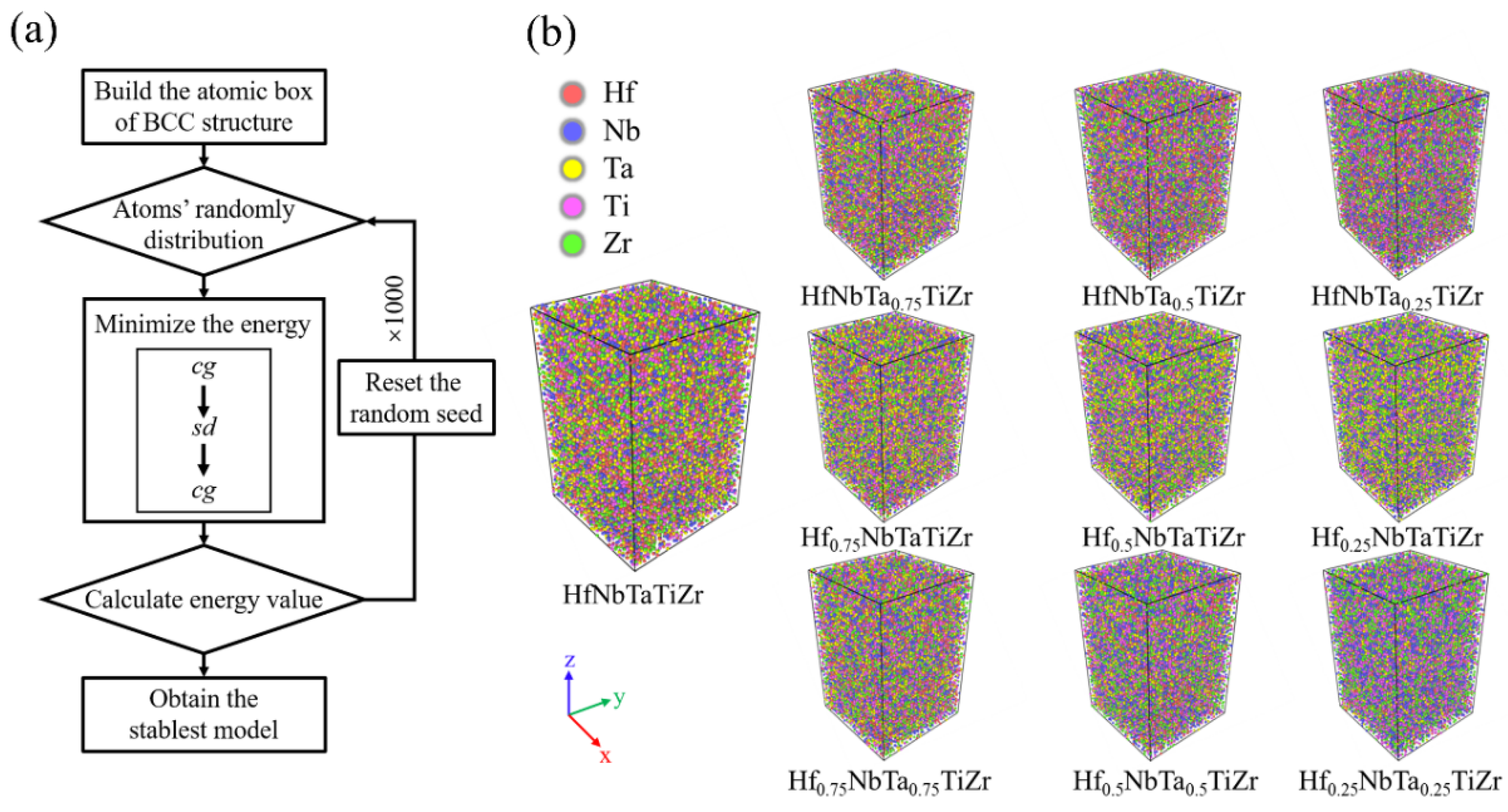
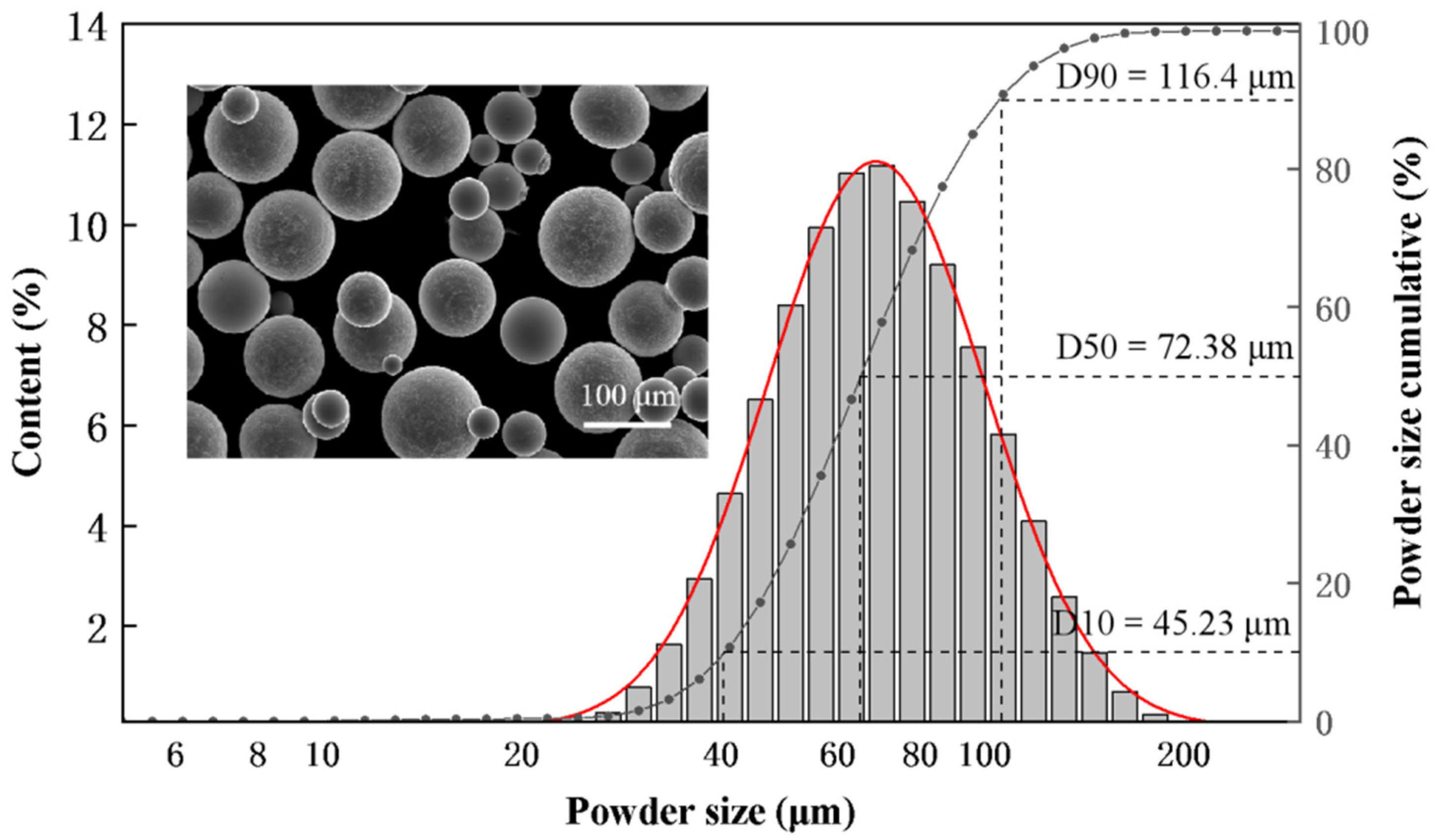
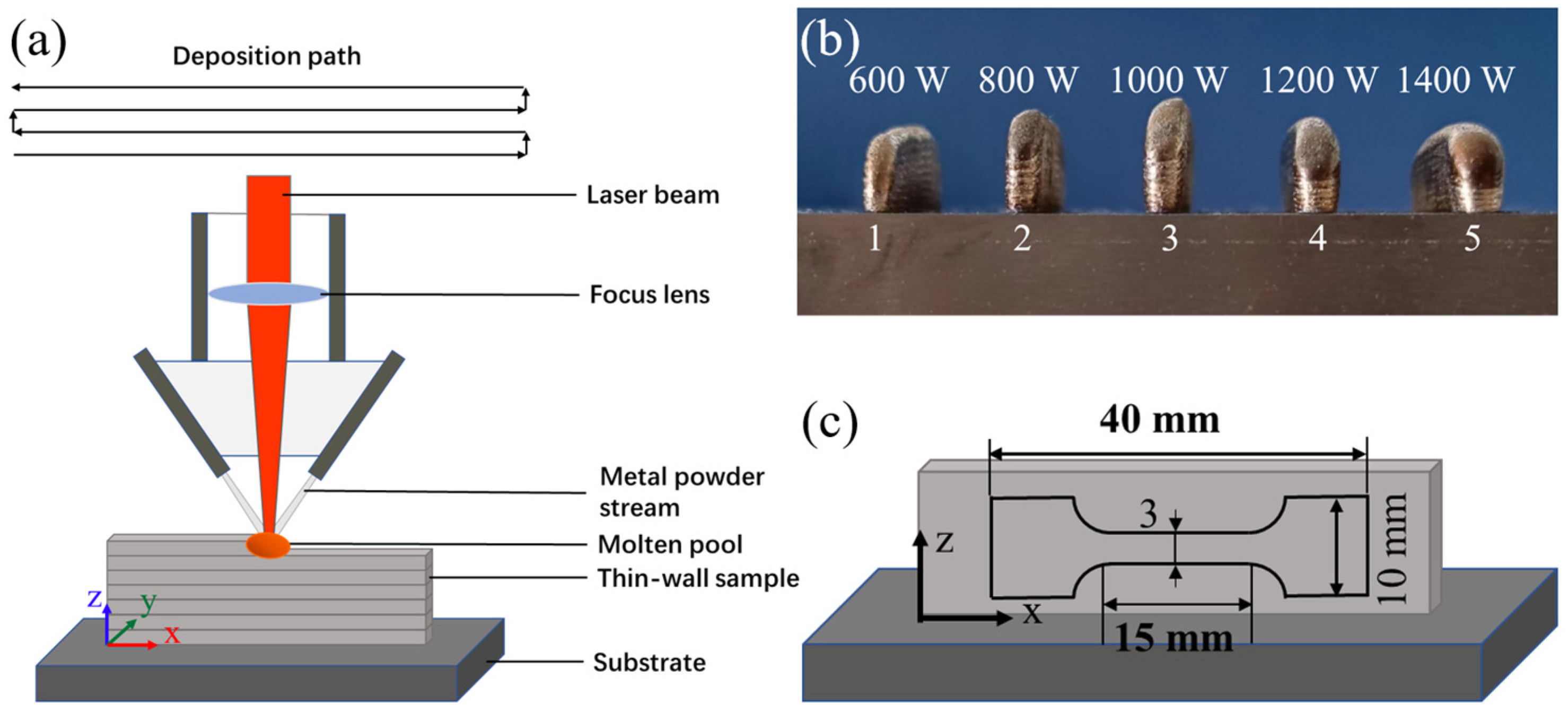
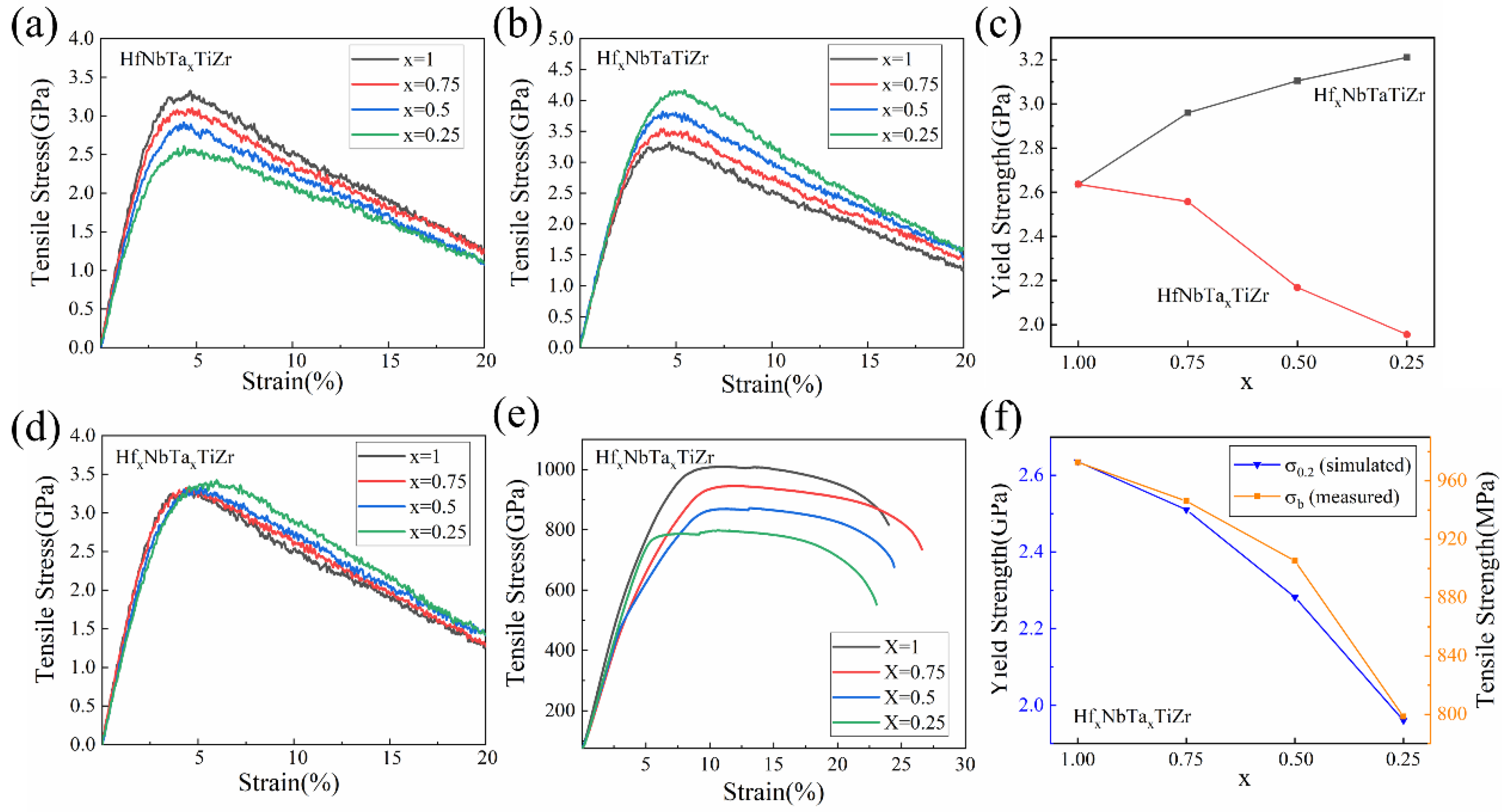

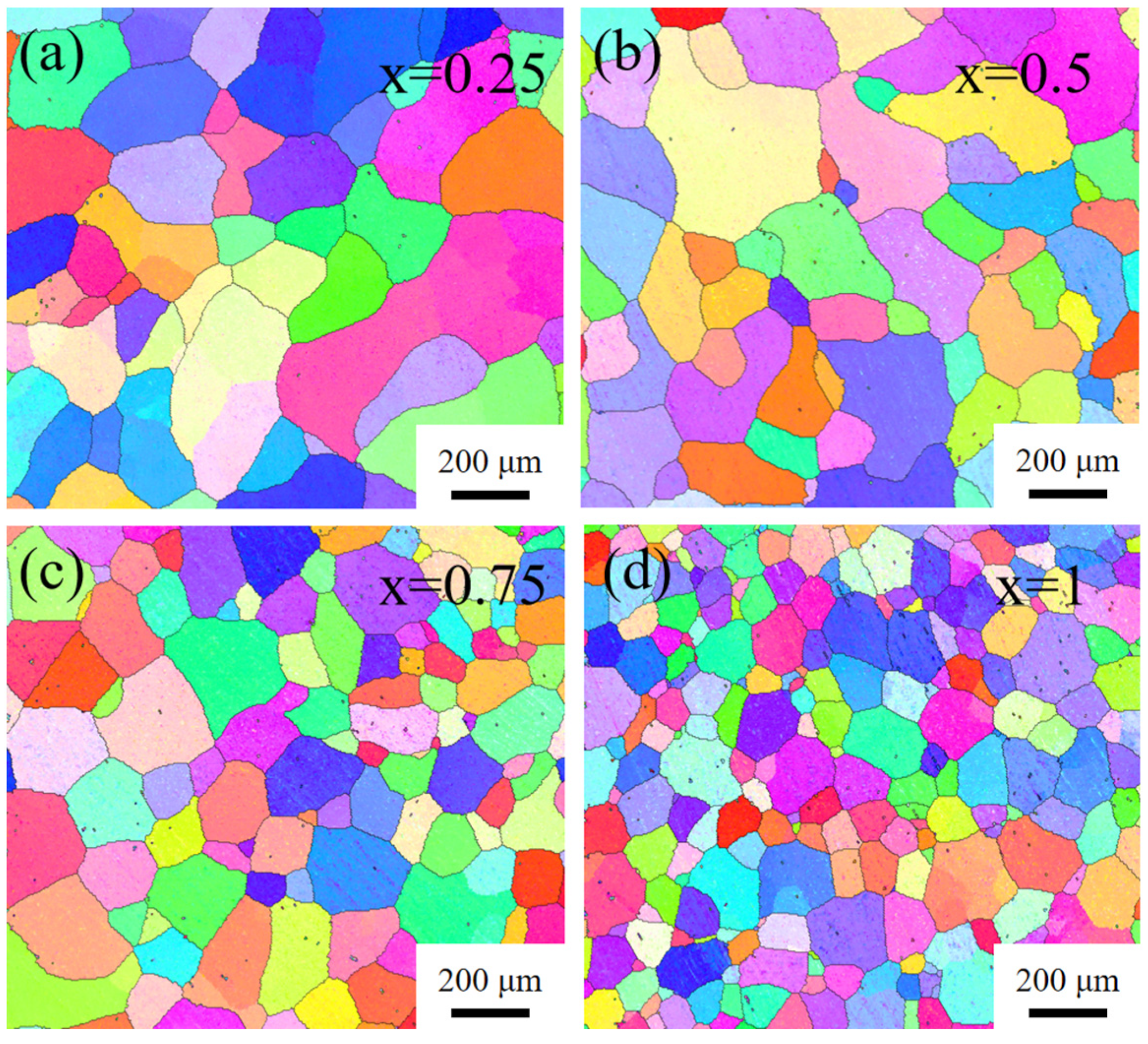
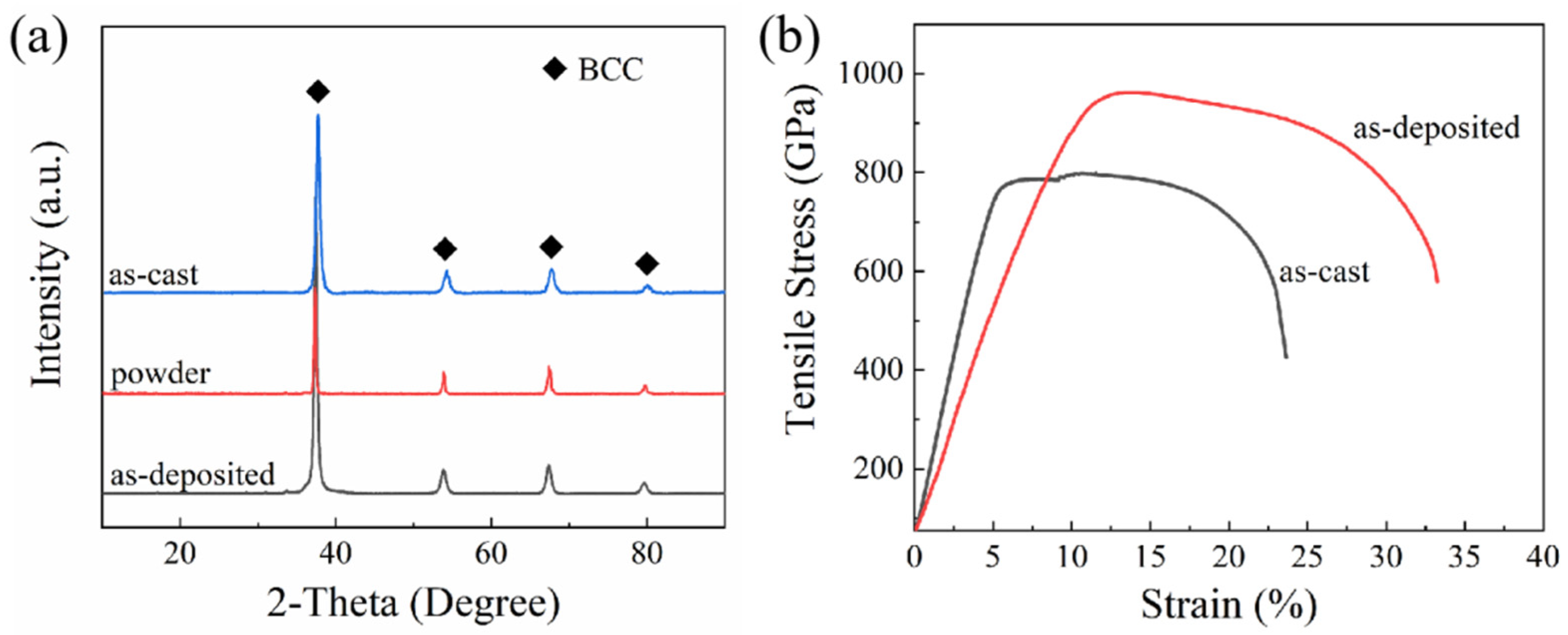
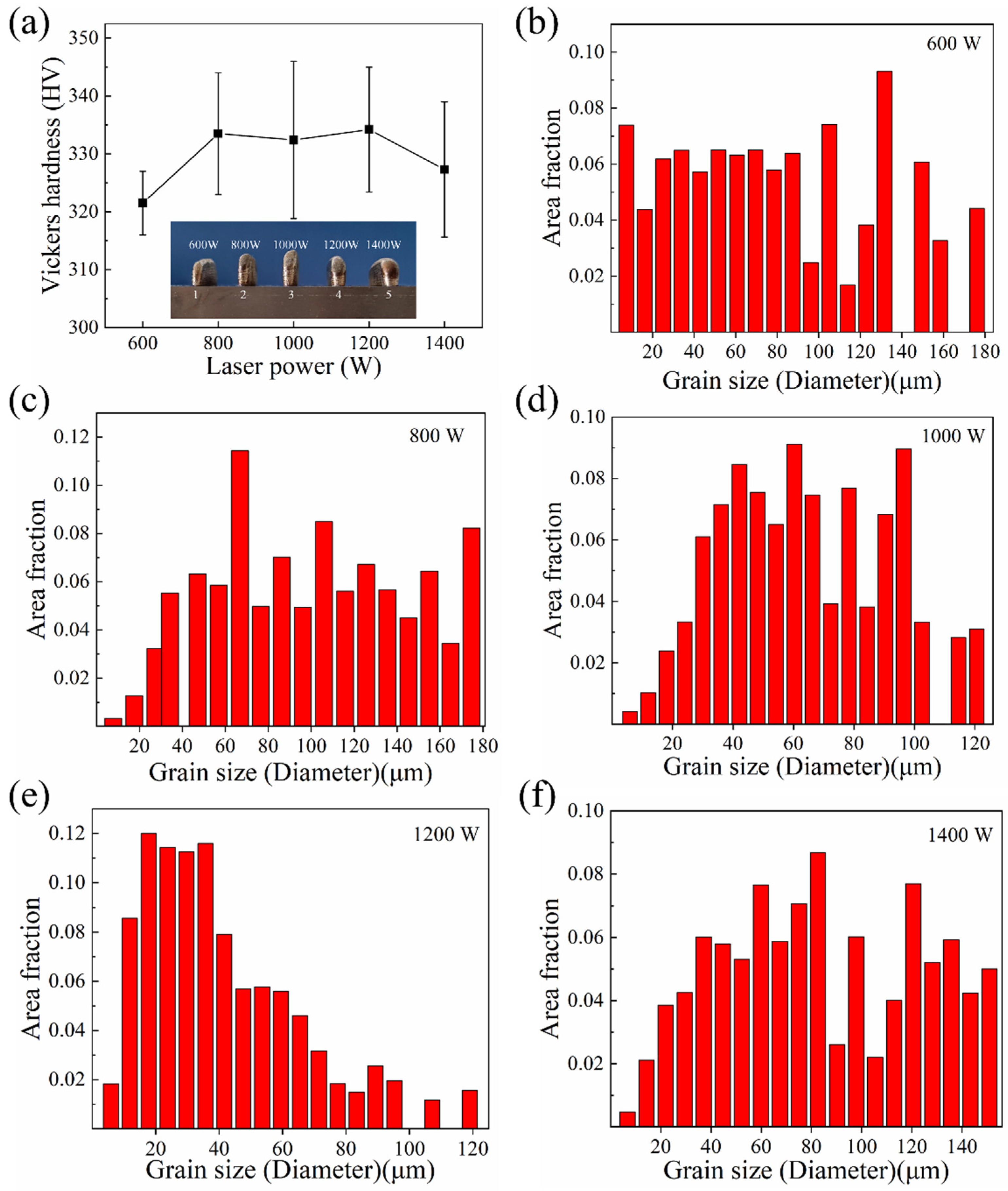

| Alloys | σs (MPa) | Rm (MPa) | A (%) | |
|---|---|---|---|---|
| As-deposited | Hf0.25NbTa0.25TiZr | 925 ± 9 | 960.4 ± 15 | 28.9 ± 2.3 |
| As-cast | Hf0.25NbTa0.25TiZr | 730 ± 23 | 756.5 ± 18 | 20.5 ± 3.8 |
| HfNbTaTiZr | 970 ± 15 | 972.7 ± 29 | 22.6 ± 2.1 | |
Disclaimer/Publisher’s Note: The statements, opinions and data contained in all publications are solely those of the individual author(s) and contributor(s) and not of MDPI and/or the editor(s). MDPI and/or the editor(s) disclaim responsibility for any injury to people or property resulting from any ideas, methods, instructions or products referred to in the content. |
© 2023 by the authors. Licensee MDPI, Basel, Switzerland. This article is an open access article distributed under the terms and conditions of the Creative Commons Attribution (CC BY) license (https://creativecommons.org/licenses/by/4.0/).
Share and Cite
Liang, Z.; Wu, Y.; Miao, Y.; Pan, W.; Zhang, Y. Composition Design and Tensile Properties of Additive Manufactured Low Density Hf-Nb-Ta-Ti-Zr High Entropy Alloys Based on Atomic Simulations. Materials 2023, 16, 4039. https://doi.org/10.3390/ma16114039
Liang Z, Wu Y, Miao Y, Pan W, Zhang Y. Composition Design and Tensile Properties of Additive Manufactured Low Density Hf-Nb-Ta-Ti-Zr High Entropy Alloys Based on Atomic Simulations. Materials. 2023; 16(11):4039. https://doi.org/10.3390/ma16114039
Chicago/Turabian StyleLiang, Zhuoheng, Yiming Wu, Yu Miao, Wei Pan, and Yongzhong Zhang. 2023. "Composition Design and Tensile Properties of Additive Manufactured Low Density Hf-Nb-Ta-Ti-Zr High Entropy Alloys Based on Atomic Simulations" Materials 16, no. 11: 4039. https://doi.org/10.3390/ma16114039
APA StyleLiang, Z., Wu, Y., Miao, Y., Pan, W., & Zhang, Y. (2023). Composition Design and Tensile Properties of Additive Manufactured Low Density Hf-Nb-Ta-Ti-Zr High Entropy Alloys Based on Atomic Simulations. Materials, 16(11), 4039. https://doi.org/10.3390/ma16114039





